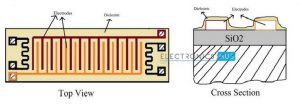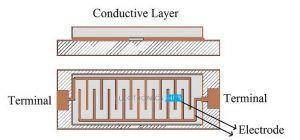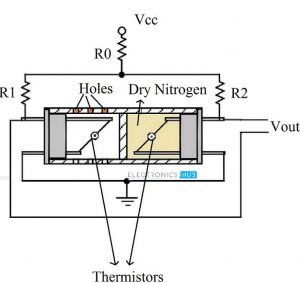Humidity is defined as the amount of water present in the surrounding air. This water content in the air is a key factor in the wellness of mankind. For example, we will feel comfortable even if the temperature is 00C with less humidity i.e. the air is dry.
But if the temperature is 100C and the humidity is high i.e. the water content of air is high, then we will feel quite uncomfortable. Humidity is also a major factor for operating sensitive equipment like electronics, industrial equipment, electrostatic sensitive devices and high voltage devices etc. Such sensitive equipment must be operated in a humidity environment that is suitable for the device.
What is a Humidity Sensor?
Humidity Sensors are the low cost-sensitive electronic devices used to measure the humidity of the air. These are also known as Hygrometers. Humidity can be measured as Relative humidity, Absolute humidity, and Specific humidity. Based on the type of humidity measured by sensor, these are classified as Relative Humidity sensor and Absolute Humidity sensor
Humidity Sensors – Classification and Working Principles
Absolute Humidity (AH) sensors or Relative Humidity (RH) sensors. Humidity Sensors can also be classified based on the parameter used for measuring Humidity i.e. Capacitive Humidity Sensors, Electrical Conductivity (or Resistive) Humidity Sensors and Thermal Conductivity Humidity Sensors.
There are other types of Humidity Sensors or Hygrometers like Optical Hygrometer, Oscillating Hygrometer and Gravimetric Hygrometer.
Capacitive Humidity Sensors
Humidity Sensors based on capacitive effect or simply Capacitive Humidity Sensors are one of the basic types of Humidity Sensors available. They are often used in applications where factors like cost, rigidity and size are s of concern. In Capacitive Relative Humidity (RH) Sensors, the electrical permittivity of the dielectric material changes with change in humidity.
Working of Capacitive RH Sensors
A simple Capacitive RH Sensor can be made from an air filled capacitor as the moisture in the atmosphere changes its permittivity. But for practical applications, air as a dielectric is not feasible. Hence, the space between the capacitor plates is usually filled with an appropriate dielectric material (isolator), whose dielectric constant varies when it is subjected to change in humidity. The common method of constructing a capacitive RH sensor is to use a hygroscopic polymer film as dielectric and depositing two layers of electrodes on the either side.
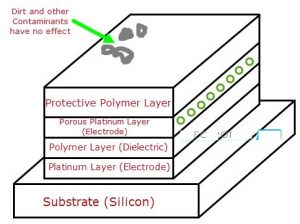
Another way to use the capacitive RH sensors is to observe the changes in the frequency of the oscillator constructed using a capacitor with RH sensitive test subject as dielectric. This setup is often employed in pharmaceutical products.
The test samples like medical tablets are placed between two plates (which form the capacitor electrodes) to form a capacitor in the LC Oscillator circuit. The frequency of the oscillator changes with humidity surrounding the test sample.
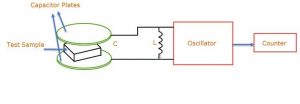 Let us see the construction of a thin thermostat polymer film based capacitive RH Sensor. It is fabricated on a silicon substrate. On this substrate, two metal electrodes made of either aluminium, platinum or chromium are deposited. The shape of these electrodes is carved out such that, the electrodes form an inter-digitized pattern. On top of this layer, a dielectric layer is deposited. The following image shows a top and cross section view of the capacitive humidity sensor. Note that two temperature sensitive resistors are deposited on the same substrate to provide temperature compensation.
Let us see the construction of a thin thermostat polymer film based capacitive RH Sensor. It is fabricated on a silicon substrate. On this substrate, two metal electrodes made of either aluminium, platinum or chromium are deposited. The shape of these electrodes is carved out such that, the electrodes form an inter-digitized pattern. On top of this layer, a dielectric layer is deposited. The following image shows a top and cross section view of the capacitive humidity sensor. Note that two temperature sensitive resistors are deposited on the same substrate to provide temperature compensation.
Disadvantages of Capacitive Humidity Sensors
Advantages of Capacitive Humidity Sensors
- The output voltage is near linear.
- They provide stable results over long usage.
- Can detect wide range of RH.
- The distance from the sensor and signalling circuit is very limited.
Applications of Capacitive Humidity Sensors
Capacitive Humidity Sensors are used in a wide range of applications including but not limited to:
- HVAC Systems
- Printers and Fax Machines
- Weather Stations
- Automobiles
- Food Processing
- Refrigerators, Ovens and Dryers
Resistive Humidity Sensors (Electrical Conductivity Sensors)
Resistive Humidity Sensors are another important type of Humidity Sensors that measure the resistance (impedance) or electrical conductivity. The principle behind resistive humidity sensors is the fact that the conductivity in non – metallic conductors is dependent on their water content.
Working of Resistive Humidity Sensors
The Resistive Humidity Sensor is usually made up of materials with relatively low resistivity and this resistivity changes significantly with changes in humidity. The relationship between resistance and humidity is inverse exponential. The low resistivity material is deposited on top of two electrodes.
The electrodes are placed in inter-digitized pattern to increase the contact area. The resistivity between the electrodes changes when the top layer absorbs water and this change can be measured with the help of a simple electric circuit.
Some of the commonly used materials are salt, specially treated substrates, solid polyelectrolytes and conductive polymers. Modern Resistive Humidity Sensors are coated with ceramic substance to provide extra protection. The electrodes in the sensor are usually made of noble metals like gold, silver or platinum.
Advantages of Resistive Humidity Sensors
- Low cost
- Small Size
- The distance between the sensor and signal circuit can be large (suitable for remote operations).
- Highly interchangeable as there are no calibration standards.
Disadvantages of Resistive Humidity Sensors
- Resistive Humidity Sensors are sensitive to chemical vapors and other contaminants
- The output readings may shift if used with water soluble products.
Applications of Resistive Humidity Sensors
Resistive or Electrical Conductive Humidity sensors are low cost sensors with relatively small size. They are often used in several industrial, domestic or residential and commercial applications.
Thermal Conductivity Humidity Sensors
Thermal Conductivity Humidity Sensors are also known as Absolute Humidity (AH) Sensors as they measure the Absolute Humidity. Thermal Conductivity Humidity Sensors measure the thermal conductivity of both dry air as well as air with water vapor. The difference between the individual thermal conductivities can be related to absolute humidity.
Working of Thermal Conductivity Humidity Sensors
The best component to accomplish thermal conductivity based humidity sensor is thermistor. Hence, two tiny thermistors with negative temperature coefficient are used to for a bridge circuit.
In that, one thermistor is hermetically sealed in a chamber filled with dry Nitrogen while the other is exposed to open environment through small venting holes. When the circuit is powered on, the resistance of the two thermistors are calculated and the difference between those two values is directly proportional to Absolute Humidity (AH).
Advantages of Thermal Conductivity Humidity Sensors
- Suitable for high temperature environments and high corrosive situations.
- Very durable
- Higher resolution compared to other types
Disadvantage of Thermal Conductivity Humidity Sensors
- Exposure to any gas with thermal properties different than Nitrogen might affect reading measurement.
Applications of Thermal Conductivity Humidity Sensors
Some of the common applications of Thermal Conductivity Humidity Sensors are:
- Drying kilns
- Pharmaceutical plants
- Owens
- Clothes dryers and drying machines
- Food dehydration
Important Considerations when Selecting a Humidity Sensor
The following are some of the factor that must be taken into consideration when selecting a Humidity Sensor.
- Accuracy of the sensor.
- Calibration – requirements and methods
- Size of the sensor
- Cost of the sensor and cost of replacement
- Output repeatability
- Circuit complexity
- Resistance to contamination
- Reliability of the sensor.
Applications
The capacitive sensor is used for various applications for measuring humidity in HVAC systems, Printers, Fax machines, Weather stations, automobiles, food processing, refrigerators, etc…
Due to the low cost and small size, resistive sensors are used in residential, industrial and domestic applications. Thermal Conductive sensors are commonly used in pharmaceutical plants, food dehydration, drying machines, etc…
Examples
Some of the examples of these sensors available in the market are DHT11, DHT22, AM2302, SHT71, etc…For accurate and reliable measurements digital sensors are used. SHT3X is the most versatile sensor. SHTW2 is the smallest humidity sensor available in the market. SHT85 provides easy replaceability.
Humidity measurement doesn’t measure humidity directly. They depend on the measurement of quantities such as temperature, pressure, mass, resistivity to calculate humidity. Digital sensors measure the change in resistivity and conductivity values to calculate the humidity.
These sensors output the digital values which makes them easy to interface and use with microcontrollers such as Arduino, Raspberry Pi boards. These sensors proved to be a very useful tool for the safety of sensitive electronic equipment which is less tolerable to the environmental changes.



